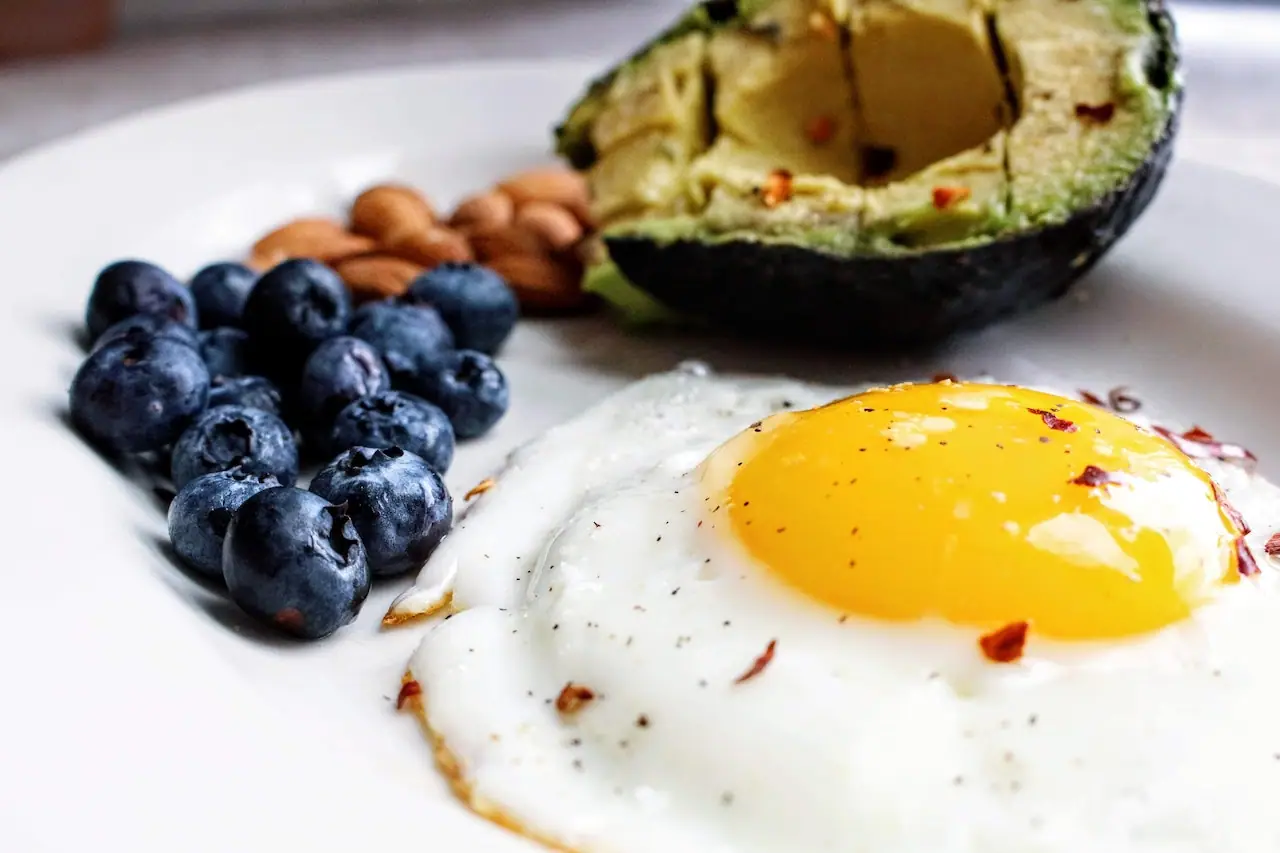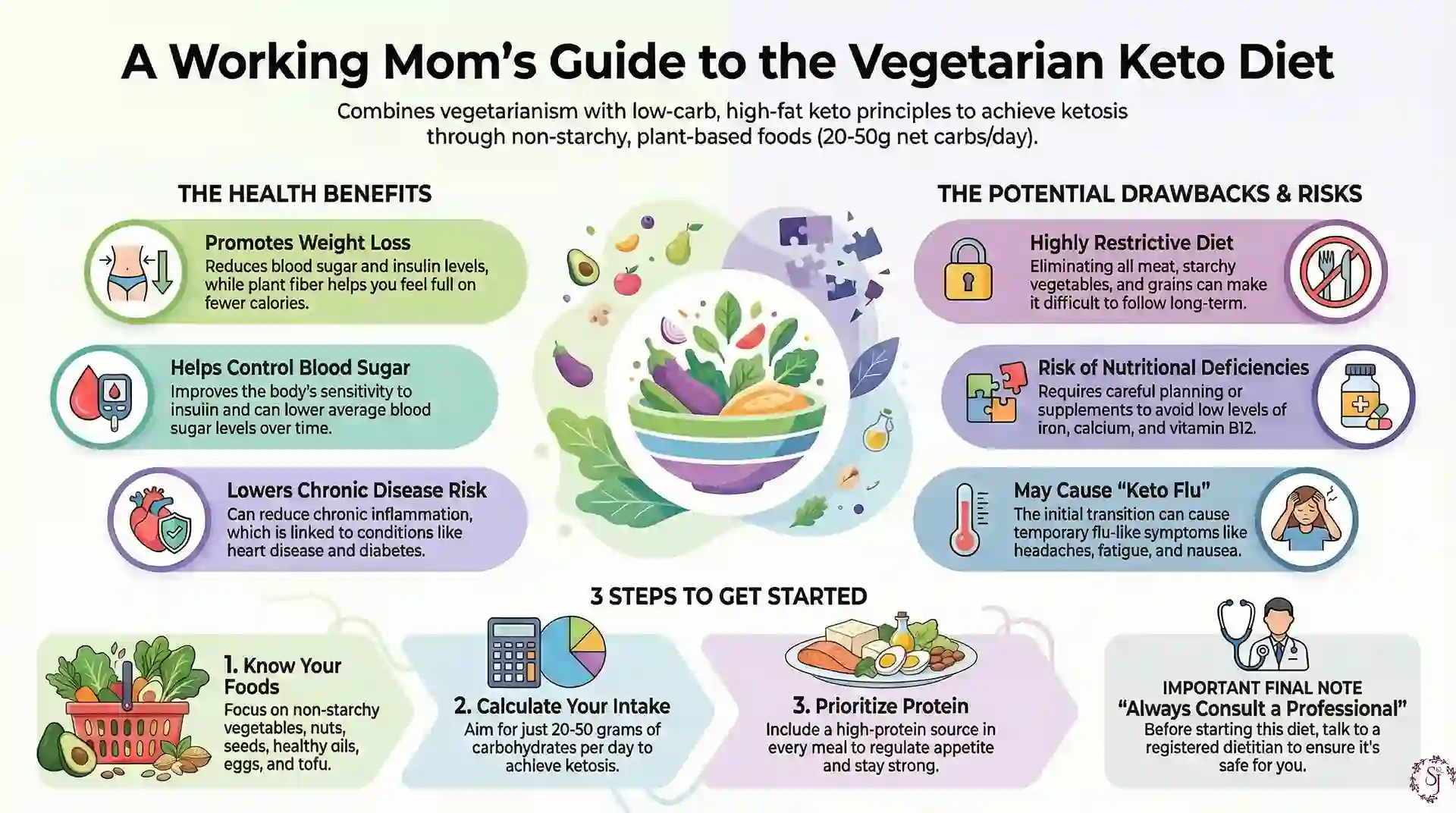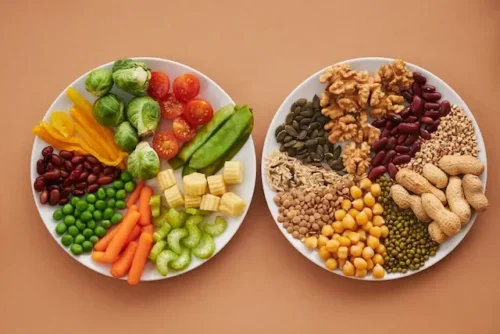
How Working Moms Can Prepare A 7-Day Vegetarian Keto
Being a working mom is a challenge because you have to balance work and family life. And oftentimes, you tend to forget about yourself since you’re juggling all the responsibilities. As a result, you gain a little more weight for not having the time to exercise. But if you want to stay healthy, you can try a vegetarian keto diet plan.
Typically, the keto diet is the choice of diet for meat lovers due to the fact that it places a strong emphasis on eating meals with lots of fat. And while many people associate the keto diet with eating plenty of meat and greasy burgers, it’s actually possible to adopt a more plant-based lifestyle to accommodate vegetarians.
If you’re a working mom, who’s also a vegetarian, trying a vegetarian keto diet but don’t know where to start, we’ve got you covered. This blog will help you prepare a 7-day vegetarian keto diet plan. Let’s get started.
An Overview of A Vegetarian Keto

This visual summary helps simplify how the vegetarian keto diet works and what to consider before starting. The key ideas focus on food choices, awareness of risks, and balancing macronutrients to support ketosis. Reviewing these points before planning meals can make it easier to start confidently.
The vegetarian keto diet combines vegetarianism and keto dieting in one eating plan. The goal is to consume 20-50 grams of carbohydrates on a daily basis to put your body into the fat-burning state called ketosis. And unlike the traditional keto diet, where you get your daily calories from fat, you’re only allowed to eat healthy fats and non-starchy plant-based food in a vegetarian keto. These include avocados, eggs, nuts, and more. But you can always add full-fat dairy to satisfy your protein and fat needs and supplements for micronutrients like potassium, calcium, iron, zinc, and B vitamins.
Now that we’ve learned what a vegetarian keto diet looks like, let’s have a better understanding of its advantages and disadvantages.
Benefits and Drawbacks of Vegetarian Keto
While there are no studies that examine the exact benefits and risks of the vegetarian keto diet, a ton of research exists on its parents, vegetarian and keto diets. Here’s what found on them:
Benefits
Promotes Weight Loss
Studies have shown that both the ketogenic and vegetarian diets promote weight loss. Low-carb veggies and meats, which are among the keto-friendly foods, help you lose more fat by reducing your blood sugar and insulin levels. All the while, plants have fiber, which can make you feel full on fewer calories. And if you increase your protein intake on your vegetarian keto diet, it can help speed up your metabolism. Meanwhile, eating good fats like medium-chain triglycerides can help control your hunger.
Helps With Controlling Blood Sugar Levels
Besides weight loss, research has found that vegetarian and keto diets help control your sugar levels and increase your body’s sensitivity to insulin. This is most likely because both diets reduce your energy intake, which enhances your glycemic control. Another theory is that dietary fiber delays the intestine’s absorption of glucose. This prevents blood sugar from rising.
Either way, both of these diets help improve your body’s blood sugar regulation and lower the levels of your hemoglobin A1c (HbA1c), which is your average blood sugar over the past three months.
Lowers The Risk of Chronic Diseases
As you might already know, food improves both physical and mental health. But with the right intake and kind of food, it can help you further. Vegetarian and keto diets are proven to help lower the risks of various chronic health conditions, such as heart disease, diabetes, obesity, non-alcoholic fatty liver disease (NAFLD), and even Alzheimer’s disease.
During ketosis, your liver produces beta-hydroxybutyrate (BHB) that suppresses the NLRP3 inflammasome, which is involved in disease development. As a result, the ketogenic diet reduces chronic inflammation, which increases the risks of illnesses. And since being a vegetarian also means removing foods with refined carbs, you also avoid triggering chronic inflammation.
Drawbacks
Lack of Food Variety
The vegetarian keto diet is not for everyone, even for those who have gotten used to the traditional keto diet. It’s a highly restrictive diet knowing you’ll remove meat from all your meals. And it can take a lot of time to change your dietary habits. On the bright side, since you don’t have much food variety, it can be easy to stick to your budget. Nevertheless, it’s best to talk to a healthcare professional before going all in on this diet.
May Lead To Nutritional Deficiencies
When going for a vegetarian keto diet, know that you’re also eliminating nutrient-dense food, such as starchy vegetables, whole grains, and meat. The only food you can eat is keto-plant-based meals, which often lack vitamin B12, calcium, iron, and zinc. As a result, you increase the risk of nutritional deficiencies.
Given this, it’s important to monitor your nutrient intake, eat a range of healthy, whole foods, and take supplements to ensure you’re getting the vitamins and minerals your body needs.
May Cause Flu-Like Symptoms
Reducing the number of carbohydrates you eat to 50 grams or less may cause keto flu. It’s a combination of flu-like symptoms that occurs when your body transitions into ketosis. You may experience symptoms like headaches, fatigue, constipation, muscle cramps, and nausea. To avoid them, it’s important to get enough fats and electrolytes. You can incorporate healthy-based foods like avocados, flaxseeds, and almonds into your diet plan. Moreover, you must always stay hydrated, have plenty of rest, and exercise regularly.
Read More: 7 Effective Tips For Your Healthy Diet
How To Prepare A 7-Day Vegetarian Keto Diet Plan
Shifting to vegetarian keto can be as difficult as being a working mom. But of course, it’s achievable with your dedication. You can follow the steps below for a 7-day diet plan.
Know The List of Foods You Can Eat
Since you’re following a strict diet, it’s essential to know the specific food you can include in your 7-day plan. That way, you can ensure that you’re getting a balanced diet low in calories but rich in nutrients. To help you bypass searching the web, here’s a list of food you can eat on a vegetarian keto diet:
- Non-starchy vegetables: cruciferous vegetables (broccoli, cabbage, cauliflower, bok choy, kale), zucchini, green beans, bell peppers, tomatoes, salad greens (lettuce, spinach), and mushrooms
- Nuts: almonds, walnuts, pecans, cashews, macadamia nuts, hazelnuts, pistachios, and Brazil nuts
- Seeds: chia seeds, flaxseeds, pumpkin seeds, hemp seeds, sunflower seeds, and sesame seeds
- Low-carb fruits: avocado, blueberries, lemons, strawberries, limes, raspberries, and cantaloupe
- Protein: eggs, tofu, spinach, nutritional yeast, tempeh, natto, and keto-friendly vegetarian protein powder
- Healthy plant-based fats: olive oil, coconut oil, avocado oil, and MCT oil
- Full-fat dairy products: milk, cheese, yogurt, heavy cream, and butter
- Herbs and seasonings: basil, salt, pepper, paprika, rosemary, turmeric, oregano, and thyme
Calculate Your Nutrient Intake
It’s always essential to calculate and monitor your nutrient intake on every diet you get into. But most especially when you’re going on vegetarian keto since it’s a very restrictive diet. And as you know, the more restrictive your diet is, the more care you’ll need to get the essential nutrients your body needs.
Since you focus on lowering the carbs and increasing the fats to get into ketosis, you limit your food intake. As a result, your body tends to be low in certain vitamins and minerals. Thus, by calculating your nutrient intake (macro and micronutrients) as you develop your 7-day diet plan, you can achieve your goals without torturing your body.
Take note that your carbohydrate intake should only be between 20-50 grams per day, depending on your goal. To help your body during ketosis, load up on other keto-based foods that are rich in electrolytes, vitamins, and minerals.
Include A High-Protein Source In Every Meal
Since you’re cutting out carbs and focusing on fats, it’s important to include a high-protein source on every meal in your 7-day vegetarian keto plan. Doing so can provide your body with the essential amino acids it needs to regulate appetite and keep blood sugar levels stable. Because without sufficient protein, your body can become weak and unable to perform optimally on ketosis.
However, of course, you might want to use low-carb proteins like nuts, seeds, soy, dairy, and eggs. Also, take note that the grams of protein you’ll have will depend on your body composition, age, activity level, and health conditions. Diet Doctor recommends aiming for 1.2 to 2.0 grams of protein per kilo of reference body weight.
Use Healthy Oils
Since fats are your primary source of calories on a vegetarian keto diet, it’s crucial to use healthy oils. They provide essential fatty acids that vegetarians need for their diet. Plus, they also improve the absorption of vitamins and minerals from the foods you eat, providing a more balanced nutrition. Best of all, healthy oils add more flavor and texture to your dishes, making them more delicious.
Season With Various Herbs And Spices
Herbs and spices will be your one-stop solution to diversify your dishes. They will add flavor and depth to every meal you want to include on your vegetarian diet plan. But that’s not the end of it. They’re also an additional source of micronutrients and contain a few carbohydrates, perfect for your diet. Using herbs and spices to flavor your vegetarian keto meals can help you to stick to your diet while still enjoying delicious, flavorful meals.
The five easy steps mentioned above will help you prepare a 7-day plan. Still, always remember to be creative and experiment with your dishes. That way, you’ll get by the vegetarian keto diet just fine. To help you even further, see our sample 7-day vegetarian keto diet plan below.
Sample 7-Day Vegetarian Keto Diet Plan
Here are a few healthy breakfast, lunch, snacks, and dinner recipes that you can incorporate to your vegetarian keto diet:
Day 1
Breakfast: Chia seed pudding with berries, nuts, and almond milk
Lunch: Cauliflower-crust pizza with cheese, diced tomatoes, mushrooms, olive oil, and spinach
Snack: Cucumber slices paired with hummus
Dinner: Zucchini noodles with tempeh meatballs, tomatoes, and spinach
Day 2
Breakfast: Healthy smoothie using full-fat milk, MCT oil, peanut butter, and chocolate whey protein powder
Lunch: Veggie salad bowl with purple cabbage, lettuce leaves, zucchini, and walnuts, dipped in apple cider vinegar
Snack: Flax crackers with sliced cheese
Dinner: Cauliflower fried rice made with coconut oil, low-carb veggies, and tofu
Day 3
Breakfast: Greek yogurt with walnuts, chia seeds, and cacao nibs
Lunch: Taco lettuce wraps with cilantro, walnut-mushroom meat, avocado, tomatoes, sour cream, and cheese
Snack: Celery sticks with cream cheese dip
Dinner: Quinoa bowl with avocado, black beans, and tomatoes
Day 4
Breakfast: Smoothie with blueberries, almond milk, and cashew butter
Lunch: Leafy green salad topped with walnuts, pumpkin seeds, sliced avocado, and olive oil
Snack: Chia seed pudding with unsweetened coconut on top
Dinner: Spaghetti squash with chickpeas and roasted red pepper sauce
Day 5
Breakfast: Keto-friendly pancake with almond milk, nuts, and berries
Lunch: Mac and cheese made with cauliflower, broccoli, avocado oil, and tempeh bacon
Snack: Sliced carrots with guacamole dip
Dinner: Portobello mushroom fries using eggs, almond flour, and seasoning
Day 6
Breakfast: Tofu scramble with mixed veggies and cheese
Lunch: 3 pesto muffins using pesto, spinach, sun-dried tomatoes, feta cheese
Snack: Roasted pumpkin seeds and mixed nuts
Dinner: Vegetarian keto lasagna using eggplants, marinara sauce, spinach, and cheese
Day 7
Breakfast: Keto oatmeal with flax seeds, hemp seeds, heavy cream, peanut butter, and cinnamon
Lunch: Baked egg-avocado boats topped with chives, paprika, and coconut bacon
Snack: Baked kale chips with cheese dip
Dinner: Authentic Greek salad made with medium tomatoes, cucumber, olives, feta cheese, and extra virgin olive oil
Read More: 7 Day Vegetarian Keto Budget-Friendly Meal Plan For You!
The Bottom Line
Even though the vegetarian keto diet is very restrictive due to the fact that you’re also eliminating meat and seafood, it is doable. As a powerful woman working inside and outside your home, you can still achieve your weight goals by doing this diet.
However, we only recommend the full vegetarian keto diet if you’re already a vegetarian. The reason for this is that it will limit your food choices, which can break your commitment long-term.
But still want to try this diet even though you were not a vegan before, it would be best to consume most of your calories from plant-based sources without restricting yourself to the vegetarian diet. That way, you’ll avoid the yo-yo dieting cycle that can lead to more weight gain and a disordered relationship with food.
We hope our blog helps kick-start your journey to vegetarian keto.
Important note: Before starting this diet, consult with a registered dietitian to ensure that it’s safe for you.



